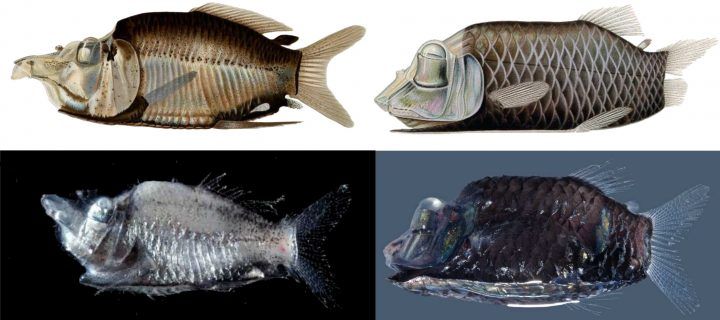
Two newly discovered species of deep sea fish have a fire in their belly. Well, not literally, but that's what it looks like. The fish, which are both in a group commonly called mirrorbellies or barreleyes, have light-producing bacteria in a pouch in their intestines.
These fish can change the orientation of this pouch, contracting it to block out light and expanding it to let it shine through. Transparent scales on their underside serve as a "screen" upon which the light can be seen, according to a study describing the finding, published in August in the journal PLOS One.
The researchers have dubbed these new species the gray and black mirrorbelly—or, if your prefer, Monacoa niger and Monacoa griseus.
The mirrorbellies are typically found at depths between 1,300 and 3,000 feet (400 to 700 meters), part of the ocean's twilight zone, where very dim sunlight filters down. Like some other denizens of these depths, they use bioluminescence to produce a small amount of light, so they don't stand out and cast a shadow below them; they produce exactly the same amount of light as is filtering down from above, granting them camouflage. But researchers think these fish may also manipulate how they emit light to communicate with one another.
The two new species have different markings on their underside that the animals probably use to recognize one another, first author Jan Poulsen, from Sydney's Australian Museum but based in Greenland, told PLOS Research News. The different patterns of coloration also allowed the researchers to distinguish them from other similar fish. The scientists write that these markings can be lost once fish are preserved in alcohol or formalin, which is standard scientific practice. So it's better to identify the creatures or at least take photos of them before dunking them in this fluid, they note.
Poulsen told PLOS that she hopes to next observe them live in the wild. "Deep sea fishes are some of the most extraordinary creatures on our amazing planet," she said. "When you have worked with these creatures, it is very hard not to become partly obsessed with what is down there."

Uncommon Knowledge
Newsweek is committed to challenging conventional wisdom and finding connections in the search for common ground.
Newsweek is committed to challenging conventional wisdom and finding connections in the search for common ground.
About the writer
Douglas Main is a journalist who lives in New York City and whose writing has appeared in the New York ... Read more
To read how Newsweek uses AI as a newsroom tool, Click here.








